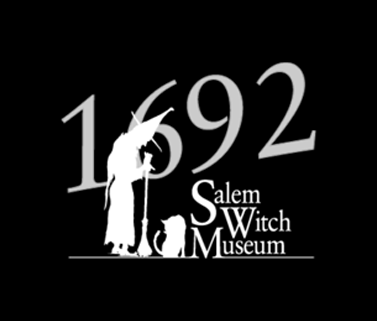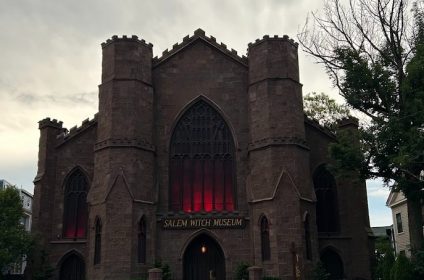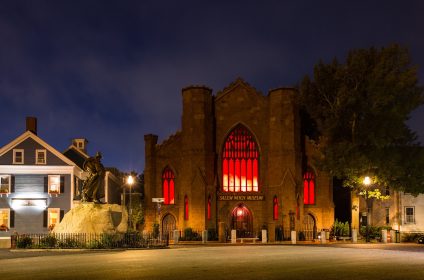-
In seventeenth-century New England a witch was believed to be an individual who sold their soul to the Devil. In return for this sacrifice, the Devil was thought to provide this person with supernatural powers that could be used to wage war against faithful Christians. As it was believed any person could become a witch, man, woman, or child, these frightening creatures were understood to by hiding in plain sight and could be blamed for a range of misfortunes.
At this time, Massachusetts Bay Colony operated under English law, which defined witchcraft as a capital crime publishable by death. Though a serious criminal offense, witchcraft suspicions rarely escalated to trial in colonial New England. In fact, in the 25 years leading up to the Salem witch trials, only one person was executed for witchcraft in Massachusetts.
There is no contemporary evidence that indicates anyone accused of witchcraft in Salem was in fact a witch. Instead, it is clear those who confessed did so under extreme pressure and fabricated elaborate stories under duress.
It is interesting to note the practice of folk magic persisted in both England and New England throughout this period. Though frowned upon by the church, many people continued to use charms and old folk remedies in an effort to cure illnesses, find lost objects, protect their homes, or find witches hiding in the community. These practices were not necessarily associated with being a witch, a much more insidious crime, and the use of simple folk magic rarely led to a witchcraft accusation.
Salem Witch Museum
- Viewed - 496
Year of the Witch Trails
Accused Witches
Thousand Witches in US
Behind These Veiled Doors
The Salem Witch Museum examines one of the most enduring and emotional events in American History, the Salem witch trials of 1692. The museum consists of two presentations. The first provides an immersive look into the events of 1692. Visitors experience the drama of that dark time though thirteen life-size stage sets, figures, lighting and narration as they are witness to the web of lies and intrigue of the Salem witch-hunt.
Our second exhibit, Witches: Evolving Perceptions, explores the meaning behind the word witch and evolution of the image of the witch over time. This presentation focuses on the European witch trials and the background leading to the Salem witch trials. In addition, this presentation discusses the emergence of the stereotypical witch and the phenomenon of witch-hunting.
The museum is open year-round, every day except Thanksgiving, Christmas, New Year’s Day, and in January for several weeks as we close to paint and prepare the museum for the upcoming season. Presentations are offered every half-hour from 10:00AM to 4:30PM, with extended hours in July, August, and October. Plan to allow at least one hour for your visit. For our international visitors, we offer our main presentation in French, German, Japanese, Spanish, Italian, Russian, Mandarin, and Cantonese by request.
PLEASE NOTE:
- The museum presentation depicts tragic history, including a tableau of the Devil, the pressing of Giles Corey, and hanging of George Burroughs. These tableaux may not be suitable for all audiences.
- We have modified our mask policy. Visitors can choose to mask or not. We will continue to monitor city, state, and CDC guidelines and may make changes to this policy as needed.
Since its opening in 1972 in a renovated historic church building, the Salem Witch Museum has served as a distinctive local landmark and major contributor to the city’s cultural and historic landscape. The mission of this organization is to be the voice to the innocent victims of witch-hunts, from 1692 to the present day. By interpreting this history through audiovisual displays, guided tours, educational resources, and virtual programming, we strive to bring awareness to the endurance of scapegoating and injustice.
Dark Delights & Offerings
Adults
Seniors
Children
Available Dates
The afflicted were those believed to be tormented by witchcraft. Beginning in January of 1692, these individuals showed alarming symptoms of a mysterious illness. They made strange, foreign sounds, huddled under furniture, writhed in pain, and clutched their heads. Those suffering from this affliction were the ones who “cried out” names, accusing others of bewitching them. Though the initial afflicted were primarily adolescent girls, eventually grown women and men also exhibited symptoms of bewitchment.
The accused were those suspected of practicing witchcraft. These people were named by the afflicted, leading to arrests and trials for the crime of witchcraft. As the mysterious affliction spread, those afflicted began to complain disembodied spirits were stabbing them, choking them, and jabbing them with pins. These disembodied spirits, or “specters,” were soon identified as real individuals living throughout Essex County. This would culminate in the arrest of 150-200 individuals.

Summoned By:
Location / Contact Info
- Address: 19 1/2 Washington Square North Salem, MA 01970
- Phone: 978-744-1692
- Mail: faq@salemwitchmuseum.com
- Website: http://salemwitchmuseum.com
Pricing / Booking
Darkened Hours
- Monday 10:00 AM - 5:00 PM
- Tuesday 10:00 AM - 5:00 PM
- Wednesday 10:00 AM - 5:00 PM
- Thursday 10:00 AM - 5:00 PM
- Friday 10:00 AM - 5:00 PM
- Saturday 10:00 AM - 5:00 PM
- Sunday 10:00 AM - 5:00 PM




Add Review